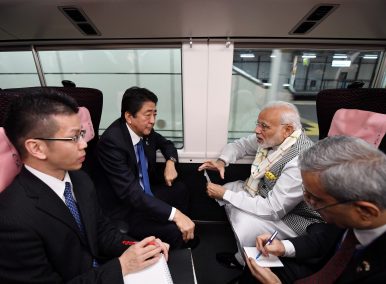By Rajeswari Pillai Rajagopalan
India’s Defense Minister Rajnath Singh is on a five-nation East Asian tour, starting with Japan, one of India’s increasingly important strategic partners. India’s ties with Japan have grown tremendously in the last decade, though there are still many areas that remain untapped in this relationship.
In Tokyo, Singh co-chaired the annual Defense Ministerial Dialogue with his Japanese counterpart Takeshi Iwaya, and his trip had several other interactions as well including a call with Japanese Prime Minister Shinzo Abe. Concerns about the strategic consequences of a rising China in the Indo-Pacific is providing greater momentum to the India-Japan partnership. This annual ministerial dialogue is one more platform for strengthening the defense and security bonds between the two countries.
India and Japan have grown particularly close since the Modi government took office in 2014. The personal chemistry between Abe and Modi has had a positive impact. Earlier this year, the two countries agreed to hold a two-plus-two ministerial dialogue with the ministers of defense and foreign affairs of the two countries. This will be the second such dialogue that India will be engaged in after the India-U.S. 2+2 strategic dialogue.
The India-Japan 2+2 dialogue is set to take place prior to the summit meeting between Abe and Modi this year, although no details are available as yet. Nevertheless, the commitment to hold such a dialogue is noteworthy as it reflects the growing desire and determination on the part of the political leadership of both countries to deepen their partnership in the security arena. This will also add to the existing dialogue platforms such as the Annual Defense Ministerial Dialogue, Defense Policy Dialogue and the National Security Adviser’s Dialogue.
After the meeting, Singh in a tweet said that he and his counterpart Iwaya had a fruitful discussion covering the entire gamut of issues in the defense and security realm. Commenting on the overall visit, the minister added that it was a remarkable one, taking forward the vision spelled out by the two prime ministers in achieving a stable and inclusive Indo-Pacific region.
While specific details of the dialogue are not known, one issue that was expected to be discussed was the sale of ShinMaywa US-2i amphibious aircraft to India. The debate on the amphibious aircraft has gone on for a while now but the deal was reportedly stuck because of pricing issues. Given the greater engagement of the Indian Navy and Coast Guard in stabilizing the Indo-Pacific, India is thought to be keen on this platform, if pricing issues can be resolved. The Japanese company developing these aircraft has offered India complete transfer of technology, besides agreeing to manufacture them in India.
Speaking to the media, the Japanese ambassador to India, Kenji Hiramatsu was very upbeat about the partnership, stating that “Mr (Rajnath) Singh’s visit to Japan is very significant to compare notes on various aspects of Japan-India defense cooperation, including some joint exercises, defense equipment cooperation and some senior-level exchanges. We are very excited to have a good discussion on opening the Pacific also. We are on the same page on various aspects of international affairs.”
The strategic rationale and context of the India-Japan relationship are clearly important, but the two countries have to move beyond dialogues and meetings to engage in some concrete efforts to cooperate in the region. One area that requires immediate attention is strategic infrastructure, an area in which China has performed very well through its Belt and Road Initiative (BRI). Giving fillip to this agenda, India and Japan announced the Asia-Africa Growth Corridor (AAGC) at the 52nd Annual Meeting of the African Development Bank (AfDB) summit in India in May 2017. The concept took off from the joint declaration issued by Modi and Abe in November 2016.
But though it has been a few years now, there is little indication that the AAGC is moving forward. The Partnership for Quality Infrastructure suggested by Japan is again an important initiative that could provide alternatives to China’s BRI. But unless these initiatives are operationalized and given the necessary momentum, India and Japan will not be able to compete with China.
Though there are clear strategic reasons for the two powers to cooperate, there are also some important difficulties the partnership faces. One is geography: the two countries are just too far away from each other to be of much use to the other. The other is the particularities of their interests: while both have a common interest in standing up to China, the specific disputes they have with China are bilateral and territorial, and it is not clear that India and Japan can support each other on these.
But on the positive side, cross service agreements that are being negotiated between the two sides will give access to each other’s military facilities and could foster much closer mil-to-mil relations. Ultimately, the reality is that while this is a partnership that still requires a lot of work, the impetus and drive to foster closer ties is clearly seen and is likely set to endure.

